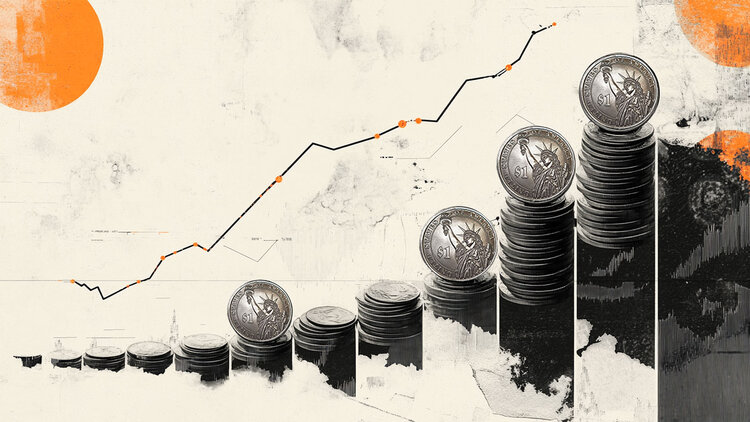- The US Consumer Price Index is set to rise 2.7% YoY in June, accelerating from May’s 2.4% growth.
- US President Donald Trump continues to threaten tariffs and undermine the Fed’s independence.
- June’s inflation data will significantly impact the direction of the US Dollar as it is a key indicator for the Fed’s interest-rate path ahead.
The United States (US) Bureau of Labor Statistics (BLS) will publish the all-important Consumer Price Index (CPI) data for June on Tuesday at 12:30 GMT.
Markets will look for fresh signs of US President Donald Trump’s tariffs feeding through into prices. Therefore, the US Dollar (USD) could experience volatility on the CPI release as the data has a significant influence on the Federal Reserve’s (Fed) interest rate outlook for this year.
What to expect in the next CPI data report?
As measured by the change in the CPI, inflation in the US is expected to rise at an annual rate of 2.7% in June, having recorded a 2.4% increase in May. The core CPI inflation, which excludes the volatile food and energy categories, is forecast to rise 3% year-over-year (YoY), compared to the 2.8% acceleration reported in the previous month. Overall, inflation is expected to tick up further away from the Fed’s 2% target
Over the month, both the CPI and the core CPI are seen advancing by 0.3% in the same period.
Previewing the report, analysts at TD Securities said: “June core CPI likely rebounded to 0.27% month-over-month (MoM) following last month’s surprising decline to 0.13%. We look for goods prices to gather steam in June, reflecting some tariff passthrough, and rebounding from last month’s modest contraction.”
“Unlike May, we don’t expect the services segment to help offset that strength. Headline also likely increased 0.27%, aided by energy prices,” they added.
How could the US Consumer Price Index report affect EUR/USD?
Heading into the US inflation showdown on Tuesday, markets digest a slew of fresh tariff threats by President Trump so far this month.
Over the weekend, Trump threatened a 30% tariff on imports from the European Union (EU) and Mexico, starting on August 1, having sent tariff letters to about 20 other countries last week.
Meanwhile, Trump is piling up political pressure for more aggressive stimulus from the US central bank, undermining its independence. The President continued to bash Fed Chair Jerome Powell by saying on Sunday that “it would be a great thing if Powell stepped down.”
White House economic adviser Kevin Hassett over the weekend warned Trump might have grounds to fire Powell because of renovation cost overruns at the Fed’s Washington headquarters.
Against this backdrop, markets continue pricing in just over 50 basis points (bps) of interest rate reductions this year, with Powell sticking to his patient outlook on cuts.
The odds of a September Fed rate cut currently stand at about 60%, according to the CME Group’s FedWatch Tool, down from 65% seen at the start of the month.
The increased expectations of an extended pause by the Fed are mainly due to the latest tariff salvo from Trump and a resilient US labor market.
The June US employment data showed that the headline Nonfarm Payrolls (NFP) rose by 147,000, against expectations of a 110,000 job gain. Meanwhile, the Unemployment Rate ticked lower to 4.1% last month versus 4.2% in May.
Therefore, the inflation report for June is critical to gauging the market pricing of the Fed’s rate outlook, in turn, impacting the USD’s valuation in the near term.
An upside surprise in the monthly core CPI reading, which is not distorted by base effects, could provide additional leg to the USD recovery and weigh on EUR/USD. In such a case, the data could revive expectations of only one Fed rate cut this year.
However, a softer-than-expected monthly core inflation could ease concerns over the tariff effect on inflation, undermining the USD demand. In this scenario, EUR/USD could regain bullish traction.
Dhwani Mehta, Asian Session Lead Analyst at FXStreet, offers a brief technical outlook for EUR/USD and explains:
“The pair battles the 21-day Simple Moving Average (SMA) support at 1.1665. Meanwhile, the 14-day Relative Strength Index (RSI) indicator holds well above 50, despite the recent downtrend, suggesting that the bullish potential remains intact.”
“On the upside, the immediate resistance level is aligned at the 1.1750 psychological mark, above which the 1.1800 round level will be tested. Further north, the multi-year high of 1.1830 will come into play. Alternatively, a sustained move below the 21-day SMA could challenge the first support at the June 12 high of 1.1631. The next healthy support levels are seen at around 1.1550 and the 50-day SMA at 1.1474.”
Economic Indicator
Consumer Price Index ex Food & Energy (MoM)
Inflationary or deflationary tendencies are measured by periodically summing the prices of a basket of representative goods and services and presenting the data as the Consumer Price Index (CPI). CPI data is compiled on a monthly basis and released by the US Department of Labor Statistics. The MoM print compares the prices of goods in the reference month to the previous month.The CPI Ex Food & Energy excludes the so-called more volatile food and energy components to give a more accurate measurement of price pressures. Generally speaking, a high reading is seen as bullish for the US Dollar (USD), while a low reading is seen as bearish.
Read more.
Fed FAQs
Monetary policy in the US is shaped by the Federal Reserve (Fed). The Fed has two mandates: to achieve price stability and foster full employment. Its primary tool to achieve these goals is by adjusting interest rates.
When prices are rising too quickly and inflation is above the Fed’s 2% target, it raises interest rates, increasing borrowing costs throughout the economy. This results in a stronger US Dollar (USD) as it makes the US a more attractive place for international investors to park their money.
When inflation falls below 2% or the Unemployment Rate is too high, the Fed may lower interest rates to encourage borrowing, which weighs on the Greenback.
The Federal Reserve (Fed) holds eight policy meetings a year, where the Federal Open Market Committee (FOMC) assesses economic conditions and makes monetary policy decisions.
The FOMC is attended by twelve Fed officials – the seven members of the Board of Governors, the president of the Federal Reserve Bank of New York, and four of the remaining eleven regional Reserve Bank presidents, who serve one-year terms on a rotating basis.
In extreme situations, the Federal Reserve may resort to a policy named Quantitative Easing (QE). QE is the process by which the Fed substantially increases the flow of credit in a stuck financial system.
It is a non-standard policy measure used during crises or when inflation is extremely low. It was the Fed’s weapon of choice during the Great Financial Crisis in 2008. It involves the Fed printing more Dollars and using them to buy high grade bonds from financial institutions. QE usually weakens the US Dollar.
Quantitative tightening (QT) is the reverse process of QE, whereby the Federal Reserve stops buying bonds from financial institutions and does not reinvest the principal from the bonds it holds maturing, to purchase new bonds. It is usually positive for the value of the US Dollar.
Read the full article here
















